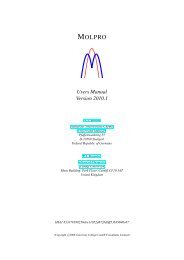CHAPTER II. POTENTIOMETRY AND REDOX TITRATIONS I ...
CHAPTER II. POTENTIOMETRY AND REDOX TITRATIONS I ...
CHAPTER II. POTENTIOMETRY AND REDOX TITRATIONS I ...
- No tags were found...
You also want an ePaper? Increase the reach of your titles
YUMPU automatically turns print PDFs into web optimized ePapers that Google loves.
vi/. Gas-Sensing Probese.g., FIGURE 2-14. “Harris” Fig. 15-22 (p. 335).Other acidic or basic gases, including NH 3 , SO 2 , H 2 S, NO x (nitrogen oxides), andNH 3 , can be detected in the same manner.IV. Redox TitrationsA redox titration is based on an oxidation-reduction reaction between analyte andtitrant.i./. Potentiometric TitrationsA potentiometric titration involves measurement of the potential of a suitableindicator electrode as a function of titration volume.e.g., Titration of Fe(<strong>II</strong>) with standard Ce(IV),FIGURE 2-15. “Harris” Fig. 16-1 (p. 349).Titration reaction: Ce 4+ (titrant) + Fe 2+ (analyte) → Ce 3+ + Fe 3+K ≈ 10 17 in 1 M HClO 4Reference half-reaction: 2Hg(l) + 2Cl − = Hg 2 Cl 2 (s) + 2eAt the Pt indicator electrode, there are two reactions that come to equilibrium,Indicator half-reaction: Fe 3+ + e = Fe 2+ E° = 0.767 V (1)Indicator half-reaction: Ce 4+ + e = Ce 3+ E° = 1.70 V (2)FIGURE 2-16. “Harris” Fig. 16-2 (p. 353).a) Region 1: Before the Equivalent PointPrior to equivalent point, amounts of Fe 2+ and Fe 3+ are both known, therefore, it isconvenient to calculate cell potential by using Reaction 1 instead of Reaction 2.E = E cathode − E anode = E + − E −= {0.767 − 0.0592⋅log([Fe 2+ ]/[Fe 3+ ])} − 0.241= 0.526 − 0.0592⋅log([Fe 2+ ]/[Fe 3+ ])When volume of titrant, V = V e /2, where V e = amount required to reach equivalent5











![Hetero [6+3] Cycloaddition of Fulvenes with N-Alkylidene Glycine ...](https://img.yumpu.com/35423358/1/190x245/hetero-6-3-cycloaddition-of-fulvenes-with-n-alkylidene-glycine-.jpg?quality=85)




